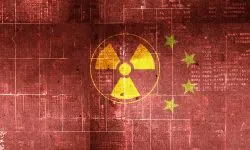(Art design: Jean-Dominique Lavoix-Carli)
On 10 April 2022, six Chinese military heavy duty transport aircraft landed at Belgrade airport in Serbia. They were delivering the Chinese FK 3 export version of the HQ-22 surface-to-air weapons systems. This delivery deepens military ties between China and Serbia, following the delivery of 14 CH-92 combat drones in 2020 (Dusan Stojanovic, “China makes semi-secret delivery of missiles to Serbia”, AP News, April 10, 2022 and Sebastien Roblin, “Missile-armed Chinese drones arrive in Europe, as Serbia seeks Airpower edge”, Forbes, July 9 2020).
It must be noted that 2020 is a strategically important period for Serbia. During this year, it also acquired urban surveillance technology from Huawei, the Chinese technology and artificial intelligence giant. At the same time, the government published the Strategy for the development Artificial Intelligence of the Republic of Serbia 2020-2025.
- DeepSeek vs Stargate – China’s Offensive on U.S. AI Dominance?
- Trump Geopolitics – 1: Trump as the AI Power President
- Uranium for the U.S. Nuclear Renaissance – 2: Towards a global geopolitical race
- The New Space Race (1) – The BRICS and Space Mining
- Uranium for the U.S. Nuclear Renaissance – 1: Meeting Unprecedented Requirements
- Fifth Year of Advanced Training in Early Warning Systems & Indicators – ESFSI of Tunisia
- Towards a U.S. Nuclear Renaissance?
As it happens, starting in 2020, Serbia had been going through a very difficult period facing the Covid-19 pandemic. In these dire times, Beijing helped Serbia by providing masks, sanitary and genome sequencing equipment ( Jean-Michel Valantin, “China, “The Health Silk Road” of vaccines and Security”, The Red Team Analysis Society, February 15, 2021, and Hamdi Firat Buyuk, Danijel Kovacevic, Edit Inotal and Milica Stojanovic, “Turkey, Serbia, Bosnia, Hungary put trust in Russian, Chinese vaccines”, Balkan Insight, January 22, 2021).
Meanwhile, Beijing involved Serbia, Montenegro, Macedonia and Greece in its Belt & Road Initiative. This involvement takes the form of the reconstruction of the Serbian network of motorways, bridges and railways. It also includes the construction of a railway that runs from Athens and the port of Piraeus to Belgrade. From there, it connects to the railway to Hungary (Silvia Amaro, “China bought most of Greece’s main port and now it wants to make it the biggest in Europe”, CNBC, November 15, 2019).
There is thus a developing convergence between the Serbian economic, military and AI strategies and the Chinese presence in the Balkans, i.e. in Southern Europe.
We shall see what the strategic orientation of the Serbian development reveals about the European and NATO dimensions of the Chinese grand strategy in Europe. This analysis will lead us to unveil the Chinese “Northern/Southern European strategy” on a warming planet.
China comes to Serbia
While the war in Ukraine has been raging since 24 February, on 10 April 2022, six Chinese heavy duty military planes fly in formation above Greece and Macedonia. Then, in a not very discreet way, they landed in Serbia, delivering HQ-22 surface-to-air missiles systems (Jovan Knezevic, “Serbia : the first and only operator of Chinese drones and missiles in Europe”, IARI Istituto Analisi Relatione Internazionali, 31 January, 2023).
The weight of history
From the Serbian strategic point of view, this delivery enlarges the military cooperation with China. This cooperation started in 2020 with the delivery of 9 “Pterodactyl 1″combat drones (Jovan Knezevic, ibid).
From the Chinese point of view, one could assume that the installation of the HQ-22 in Serbia is imbued with an even more powerful political and geopolitical content.
Indeed, one must remember that, on 7 May 1999, a U.S Air Force B-2 stealth bomber launched 5 guided bombs on the Chinese embassy in Belgrade, killing three journalists. This happened during the NATO bombing campaign against Serbia.
That campaign was waged by NATO in order to force the Serbian government to evacuate its forces out of Kosovo, accusing the actions of Serbian forces of being a security risk in the region and accusing Serbia of an active campaign of ethnic cleansing in Kosovo (David Kilcullen, The Dragons and the Snakes, How the Rest Learned to fight the West, Hurst, 2020)
NATO and the U.S. declared that this strike was nothing more than a mistake due to poor preparation. However, the political authorities in Beijing denounced the act as a deliberate “barbaric attack and a gross violation of Chinese sovereignty”.
Serbia and Chinese sovereignty
Hence, the 2022 installation of the Chinese HQ-22 in Serbia may be seen as a strategic answer to the NATO/U.S. “gross violation of Chinese sovereignty”. Equipping Serbia with powerful means of conventional deterrence against air attacks in the heart of southern Europe appears to be a strong signal of Chinese strategic assertiveness in the face of American influence.
This hypothesis is reinforced by the presence of numerous U.S. military bases in neighbouring Kosovo, Romania, Bulgaria, Greece and Germany (“List of countries with overseas U.S. military bases”, Wikipedia).
It is also interesting to note that the bombed embassy is now a huge Chinese cultural centre. Since 2014, it also hosts an antenna of the Serbian Confucius centre. The centre develops an important partnership with the Belgrade University of Novi Sad. This Confucius centre, as all the others worldwide, aims at developing the teaching of Chinese language alongside Chinese cultural influence (Reid Standish, “China builds a New Symbol in the Balkans – at the Site of a NATO Bombing”, Radio Free Europe, October 04, 2022).
Huawei, Belgrade and the AI New Silk Road
This Serbia-China military and cultural cooperation deepens with the development of the cooperation between the Chinese tech and AI giant Huawei and the Serbian Ministry of Interior (MOI). Since 2019, the MOI experiments with the installation of a network of surveillance captors in Belgrade, in order to further security. Furthermore, this cooperation also takes place in a couple of “Kosovar communities that are partly outside Pristina’s control”, which implies strong political tensions (Mila Djurdjevic, Sandra Cvetkovic, Andy Heil, “Serbia’s back-door bid to embed Chinese snooping tools in Kosovo”, Radio Free Europe, January 8, 2022).
These technologies are already widely deployed in Chinese cities, and are used, among others, to establish the “social credit” system. (Jens Kastner, “China targets Europe with drones and Huawei system sales to Serbia”, Nikkei Asia, October 2, 2019, and Jean-Michel Valantin, “Artificial Intelligence on the New Silk Road”, The Red Team Analysis Society, December 4, 2017).
Enters Huawei
At the same time, in 2020 Huawei signed a larger partnership with the Serbian government. It allows the Chinese firm to become the first commercial user of the state-owned data centre of Kragujevac. This partnership became the first Huawei digitalization centre. According to Huawei, the centre dedicates itself to the support of IT education and development of Serbia (Radomir ralev, “Huawei to use capacity at Kragujevac data centre”, SeeNews Business Intelligence for Southern Europe, Dec 09, 2020).
One has to observe that it is in this context and timeline that, in 2020, the Serbian government published its Strategy for the Development Artificial Intelligence in the Republic of Serbia 2020-2025 (Ibid, see also Hélène Lavoix, “Portal to AI-Understanding AI and Foreseeing the AI powered world”, The Red Team Analysis Society).
According to the document,
“The Strategy is in line with the European Artificial Intelligence Initiative, which sets out the European Commission’s artificial intelligence policy. In this context, the Republic of Serbia, as a candidate for EU membership, but also as a participant in the European Union Framework Program for Research and Innovation, seeks to provide the necessary extent of compliance with the European Union, which will enable full integration into the European Research Area and closer cooperation.”
(Strategy for the Development Artificial Intelligence in the Republic of Serbia 2020-2025).
It is interesting to note that the Serbian government claims that its AI strategy is coherent with EU norms.
Furthermore, in September 2020 President Alexandre Vucic, alongside with Avdullah Oti, the Kosovar Prime Minister, met President Donald Trump. Together, they ratified the “Washington Agreement”. However, this agreement refrains its signatories to install 5G infrastructure from “untrusted vendors”.
As it takes place amid the raging trade and technology war between the U.S. and China, this formal provision in the Washington Agreement alludes transparently to Huawei or other Chinese firms (Majda Ruge, Stefan Vadislajev, “Serbia’s 5G deal with Washington : the art of muddling through”, European Council for Foreign Affairs, 22 September 2020 and Diane Bartz, Alexandra Alper, “U.S bans Huawei, ZTE equipment sales, citing national security risks”, Reuters, December 1, 2022).
From the Health Silk Road…
However, one must observe that, de facto, there are already multiple layers of Serbia-China technology cooperation. Thus, this cooperation is laying the ground for an amplification of the technological and AI cooperation between the two countries.
This trend became even stronger during the high tide of the Covid-19 pandemic. In these very difficult times, in 2021, Serbia, as many other countries, received sanitary masks, medical material and Sinovac doses from China. It was thus part of the Chinese “Health Silk Road” (Jean-Michel Valantin, “China, The Health Silk Road and Security”, The Red Team Analysis Society, February 15, 2021).
It is also in the context of the pandemic that, in 2021, the Beijing Genomics Institute expanded its operation in Serbia. That was the opportunity for creating a genome sequencing centre in Belgrade by donating the necessary equipment to the Molecular Genetics and Genetic Engineering of Serbia (“China’s biotechnology helps Serbia fight Pandemic, make scientific progress : Serbian expert”, Xinhua.net, 2021/09/13, “Genome sequencing center opens in Serbia, in cooperation with China”, Xinhua.net, 2021/12/13 and Mila Djurdjevic, “Under investigation abroad, Chinese gene giant expands in Serbia”, Radio Free Europe, December 30, 2022).
… To AI genomic power?
Genome sequencing plays a central role in the struggle against the Covid-19. It allows medical authorities to identify what type of variant circulates, as well as its level of dangerousness. Thus, it allows political authorities to devise policies as adapted as possible to the level of circulation of the virus. As a result, despite its economic difficulties, Serbia was able, thanks to Beijing, to protect its population as well as possible.
Hence, Serbia has, de facto, the means to develop the hybridation of genome sequencing with artificial intelligence. This a field of fundamental research and research and development. The convergence of AI and genomics has mammoth potentials in terms, among others, of predictive medicine that strongly interests AI actors such as Huawei (“New Silk Routes Group and Huawei to develop AI for personalized cancer treatment”, AsiaBiz Today, January 21, 2021)
These biotechnology equipments as well as the development of AI have thus the potential to turn Serbia into a regional “fourth industrial revolution” power thanks to its cooperation with China. This is especially true thanks to Huawei, that is deeply committed in research and development in the field of AI and genomics (“Centre for 4IR Serbia Launched at Biotech Future in Belgrade”, Modern Diplomacy, October 20, 2022).
In the same time, Serbia is having its road and railways infrastructures renovated and expanded by Chinese companies. It also becomes a sub contractant for China since the Chinese take over of the unsafe and very polluting Smedrevo steel mill, which exports its production to China. Thus, it appears that Serbia is becoming a main hub for the Belt & Road initiative in Southern Europe (“Chinese owned steel Mill coats Serbian town in red dust, cancer spreads”, Reuters, November 9, 2021).
Reciprocally, it also means that this country acquires quite an important role in the framework of the Chinese grand strategy.
Encircling Europe and NATO
Indeed, from a Chinese point of view, Serbia is now a particularly “useful space”. If, from a Western point of view, developing the trade, military, sanitary, AI and biotechnological capabilities of Serbia for Chinappears as a strategy in itself, it also has another dimension, anchored in Chinese philosophical and strategic thought. (Valantin, “China and the New Silk Road: the Pakistani strategy”, The Red Team Analysis, May 18, 2015).
That dimension is grounded in an understanding of the spatial dimension of China, in the geographic sense. Space is not only conceived as a support to spread Chinese influence and power to the “outside”. It also allows the Middle Kingdom to “aspirate” what it needs from the “outside” to the “inside”. (Quynh Delaunay, Naissance de la Chine moderne, L’Empire du Milieu dans la globalisation, 2014).
This is why we qualify some spaces as being “useful” to the deployment of the Chinese strategy. It is also why each “useful space” is related, and “useful”, to other “useful spaces”. In the same dynamic, the different countries involved in the deployment of the Chinese strategy are “useful spaces” for China.
This philosophy of space and time as flows is the basic material of the Chinese strategic tradition. As Scott Boorman, Arthur Waldron and David Lai, among others, establish quite clearly, this tradition expresses itself especially well through the “Go game”.
This very ancient game emphasizes the importance not to control, but to master the space of the adversary (Arthur Waldron, “China’s Military Classics”, Joint Forces Quarterly, Spring 1994). The strategy is to “convert” that space into one’s own. To do so, one has to “surround and conquer” the pieces, i.e. the space of the adversary.
The strategy of useful spaces
In order to win the game, the main goal is to attack the strategy of the adversary and not “only” its space. This strategic philosophy suffuses some of the most important Chinese strategic works, such as Sun Zi’s The Art of War. It drove some of the major strategic developments during the twentieth century.
It is true, for example, of Mao’s “revolutionary warfare” against Japan and the nationalist military (Scott Boorman, ibid). As we have seen in The Red Team Analysis Society, it also drives the mammoth “Belt & Road initiative” (Jean-Michel Valantin, “China and the Belt and Road Initiative” section, The Red Team Analysis Society).
Hence, in this strategic context and tradition, the question arises of the “usefulness” of Serbia. This “usefulness” appears in the context of the worldwide deployment of Chinese influence (David Lai, ibid). In other words, how is Beijing elaborating “shih”, the strategic configuration of favorable circumstances by installing capabilities in Serbia as well as in Europe?
From Serbia to the encirclement of Europe
One must note that the recent and rapid developments of the Chinese presence in Serbia and in the Arctic follow the same timelines. In other terms, we hypothesise that Beijing plays a worldwide “Go game” at a planetary scale as well as at the European scale.
From the European point of view, the presence of China in the Arctic is particularly meaningful. As we have explained in The Red Team Analysis Society’s publications, and related conferences since 2014, the notably Russian, Chinese, Japanese, and Indian race towards the Arctic is driving the emergence of the continental Russo-Asian bloc.
Indeed, the vast Arctic Russian economic exclusive zone is attracting Russian and Asian energy developpers (Jean-Michel Valantin, “The Warming Russian Arctic: Where Russian and Asian Strategies Interests Converge?”, The Red Team Analysis Society, November 23, 2016).
The mammoth oil, gas, mineral and biological resources are becoming a giant economic attractor. Meanwhile, because of the effects of the Arctic warming, the Russian authorities open the “Northern Sea route”.
Surround and Conquer
This new sea lane follows the Siberian coast and connects the Bering Strait to Norway and the Northern Atlantic. Thus, it also connects the immense Chinese and Asian basins of economic development to Northern Europe and to the Atlantic. While the number of Chinese convoys using the Northern Sea route grows regularly, Beijing multiplies bilateral trade agreements with Norway, Finland, Sweden, Denmark and the Netherlands, consolidating its access to the European market through Northern Europe (Jean-Michel Valantin, “Arctic China (2), The Chinese Shaping of the North”, The Red Team Analysis Society, June 9, 2014).
This means that China uses its growing presence in the Arctic and in Northern and Southern Europe to increase its global influence. This happens through a subtle and multi-scale Go strategy of “surround and conquer”. This game extends from China to the Arctic and to Northern and Southern Europe and joins the multiple continental and maritime “useful spaces”.
So, while it becomes a “near Arctic nation” and a technological supporter of Serbia, China “surrounds” the whole European region (Jean-Michel Valantin, “Is the West Losing the Warming Arctic?”, The Red Team Analysis Society, December 7, 2020).
Encircling Europe
As it happens, the heightening Chinese presence in Serbia, the Balkans and Greece, “completes” the “encirclement” of Europe by the “useful Serbian hub” at its south, while developing the China’s presence in Northern Europe. In other words, Europe is “under siege”, while being largely ignorant of the conversion of multiple European spaces to Chinese technological and trade norms.
In fact, using the framework devised by Hélène Lavoix, at the level of the normative dimension of the developing war between the U.S. and China, Serbia and other European countries are adopting the Chinese technological norms (Hélène Lavoix, “The War between China and the U.S- The Normative Dimension”, The Red Team Analysis Society, July 4, 2022).
However, this happens in a region where NATO is heavily influential through the memberships of Bulgaria, Romania, North Macedonia, Montenegro, Albania, Greece, Türkiye and Italy.
By doing so, the convergence of the development strategies of China and of the Balkans states, especially Serbia, undermines the American influence in this historically strategic region.









Toujours intéressant mais plutôt inquiétant
Quelle est la réponse de l’Europe ???